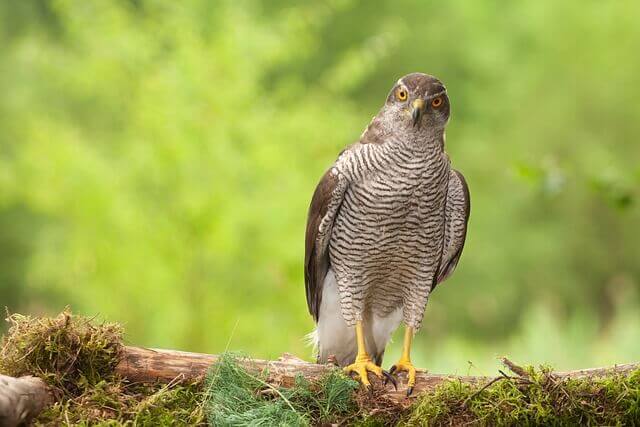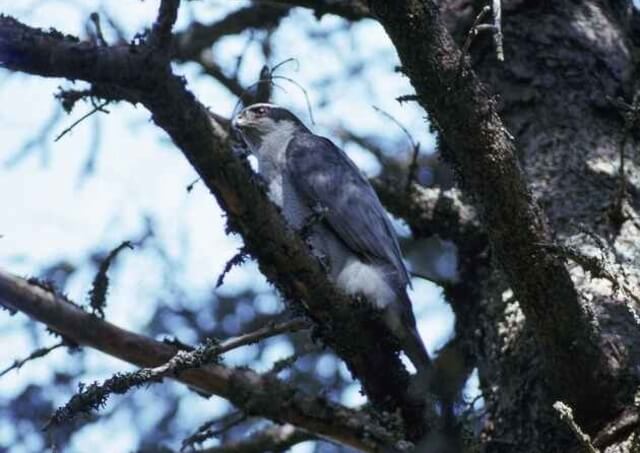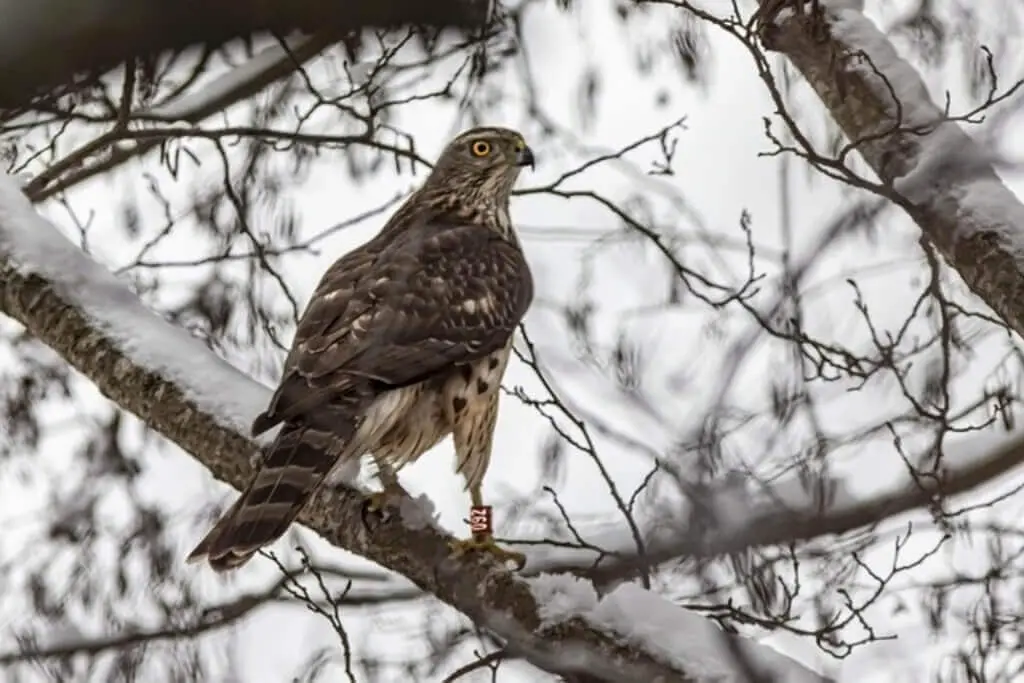The Northern Goshawk is a medium to large, raptor that is found in North America, Europe, Asia, and North Africa. It is a very skilled hunter and uses its talons, and hooked beak to catch and prey such as rabbits, squirrels, birds, reptiles and other mammals.
In this article, we will provide you with 48 fun facts about the Northern Goshawk so that you can learn more about this fascinating creature!
Table of Contents
Northern Goshawk Fun Facts
Overview
- Identification: The Northern Goshawk is a medium-large hawk that can grow over two feet in length, with a weight of about one to three pounds, and a wingspan of almost four feet. The Adult Goshawk has gray plumage on its back, and rump with light gray feathers on its chin, breast, abdomen and legs with dark horizontal barring. These birds have reddish-orange eyes with black irises, and white eyebrow stripes.
- Length: 1.75 – 2.1 feet (20.9-25.2 in.).
- Weight: 1.4 – 4.5 lbs. (22.4-72.0 oz.).
- Wingspan: 3.4 – 3.8 feet (40.5-46.1 in.).
- Kingdom: Animalia
- Phylum: Chordata
- Class: Aves
- Order: Accipitriformes
- Family: Accipitridae
- Genus: Accipiter
- Species: A. gentilis
- Binomial Name: Accipiter gentilis (Carl Linnaeus 1758).
- Scientific Name: Accipiter gentilis
- Range: North America, Europe, Asia, and North Africa.
- Migration: They are migratory birds that travel to India, Southeast Asia, the Tibetan Plateau and parts of North Africa for wintering.
- Habitat: They can be found in the boreal forests, temperate rainforests, deciduous or mixed woodlands with dense undergrowth as well as mountainous regions near rivers.
- Diet: The northern goshawk also has a diet consisting primarily of small mammals such as rats, gophers, mice, voles and squirrels but will occasionally eat other animals such as rabbits, hares, chipmunks and birds. They also eat insects and occasionally carrion.
- Global extent of occurrence: 115,000,000 km2 (44,401,748.2 sq mi.).
- Global Population: est. 1000000-2499999 mature individuals.
- European Population: Est. 332,000-440,000 mature individuals. Est. 166,000-220,000 pairs.
- Conservation Status: Listed as Least Concern (Population Stable).
- Lifespan: In the Wild: 16.5 years of age. – In Captivity: 27 years of age.
- Breeding Period: April and mid-June.
- Incubation Duration: 28-38 days.
- Nestling Duration: 34-35 days.
- Chicks Fledge: 36-42 days.
- Clutch Size: 1-5 eggs.
- Number of Broods: 1 brood per year.
- Egg Color: Bluish-white.
- Nesting Habits: The Northern Goshawk nests on the top branches (25-50 feet high) of large conifer trees such as cedars, Douglas-firs, redwoods pines, spruces, and hemlocks. The female will often repair, and reuse an old nest, or she will build a new nest bowl from sticks, twigs, plant material, and tree bark. Completed nests are large, about four feet in length, and two feet wide. Eggs are laid anywhere from April to mid-June. Incubation duration is from 28 to 38 days. Nestlings begin to hop from branch to branch when they are 36 days of age. Males begin their first flight at around 36 days, and females begin to fly at around 42 days, and they will reach independence approximately 70 days from hatching.

- Northern Goshawks are carnivorous birds of prey. This species of hawk has been known to prey on rabbits, rats, squirrels as well as other small animals.
- Goshawks do not form breeding pairs and tend to be solitary.
- Goshawks are diurnal and hunt during the day when they can easily spot their prey.
- The oldest-known Northern Goshawk ever found in the wild was almost 18 years old.
- The Northern Goshawk was first described by Carl Linnaeus as the (Accipiter gentilis) in his Systema naturae in 1758.
- Northern Goshawks are sexually dimorphic, with females being larger than the male. This difference can be significant at times.
- Males develop quicker and usually fledge sooner around (36-40 days) than females around (39-42 days).
- Northern Goshawks belong to the family Accipitridae, a group of species of vultures, eagles, hawks, kites and harriers.
- The best time to see them is in Mid- to late November, when they are migrating south for winter.
- The Northern Goshawk’s predators are the red-tailed hawk, great horned owl, short-eared owl, American marten, raccoon, bobcat, wolverine, and coyote.
- The Northern Goshawk is a native North American bird that lives all over the continent except in the southeast, southern California and Texas.
- The Northern Goshawk has a wingspan of 3-4 feet and weighs around 6-13 pounds.
- Full adulthood is usually attained at around 3 years of age.
- Most birds are inactive during winter, with most staying hidden in caves and other sheltered locations.
- They are known to migrate north during the summer months to hunt for food, but during the winter they fly south towards warmer climates for better food sources and to escape the cold.

- The northern goshawk is a known aerial predator and catches most, if not all, of its prey on the wing.
- Some goshawks also hunt from perches such as trees or bridges. When hunting from a perch, the goshawks pursue prey, typically by diving straight down at high speed and sometimes even twisting in midair to catch their prey.
- A pair of northern goshawks will typically build more than one nest within a given area and will use them successively as they become available.
- They are also sometimes mistaken for Cooper’s Hawks (Accipiter cooperii), but Cooper’s Hawks are much smaller.
- Juveniles are usually darker than adults and can be described as brownish or gray on top, with some streaking giving more of a darker appearance than their adult counterparts.
- They have excellent eyesight and hearing, and can hear their prey from a distance.
- When hunting, the Northern Goshawk creates a notched flight path with quick wing beats, so it can fly low enough to present its talons in front of the bird’s body for a grab.
- The Northern Goshawk has been hunted by humans for their feathers and meat for centuries.
- Northern Goshawks are monogamous and mate for life. This is because they form a lifelong bond with their partner, the male even helps feed the female during mating season to prepare her for egg laying.
- Nestlings hatch with their eyes open and with short white down.
- Goshawks give a loud kee-kee-kee-kee call, that is repeated as much as 20 times, when threatened or when chasing prey.
- They have the second-biggest distribution range of any true hawks, only behind the Golden Eagle.
- The northern goshawk can maintain a horizontal flight speed of over 60 km/h (37 mph) when chasing down prey.
- The male hawk is also known as a “tercel”, and the female hawk is often called a “falcon”.
Related Post:
- 20 Cooper’s Hawk Fun Facts
- 20 American Kestrel Fun Facts
- Interesting Facts about Red-shouldered Hawks
- 32 Fun Facts About Hawks
- 47 Fun Facts about Black Kite
- 55 Fun Facts about Red Kites
- Interesting Red-tailed hawk Facts
Frequently Asked Questions
Do goshawks eat pigeons?
Goshawks are large raptors that prefer hunting small mammals like squirrels, chipmunks, and rabbits. Though they do occasionally eat pigeons, these birds make up less than 10% of their diet.
Do goshawks eat squirrels?
Goshawks are carnivorous birds of prey, and have an appetite for rodents and squirrels. They especially love the gray squirrel, which is also known as Sciurus carolinensis. They hunt their prey by diving from a high tree branch and then use their talons to capture it or to crush its skull with their beak
Do Northern Goshawks eat ducks?
Ducks are not the only type of bird that these predators hunt; they will also search for other types of game-birds like quail, pheasant, and grouse.
Is the Northern Goshawk endangered?
The Northern Goshawk is not endangered. It is not listed as an endangered species in the USA. The Red List of Threatened Species classifies it as a “least concern” species, which means that it does not face any significant threats to its survival or population size.
Is a goshawk a hawk?
The Goshawk is a large hawk in the same genus as other members of the order Accipitriformes such as eagles, kites, and buzzards, which consists of 51 different species.


